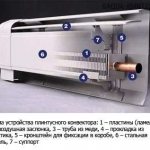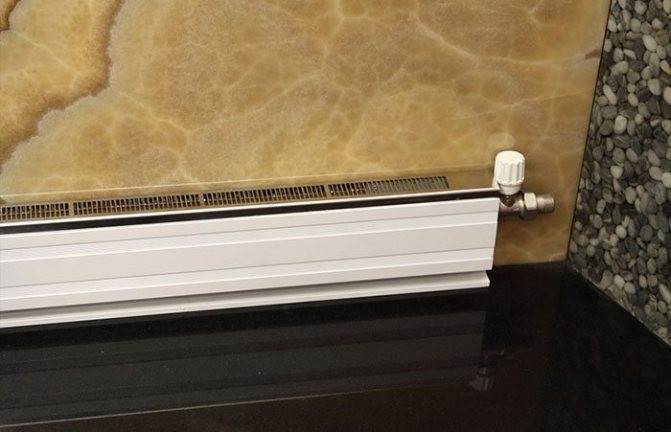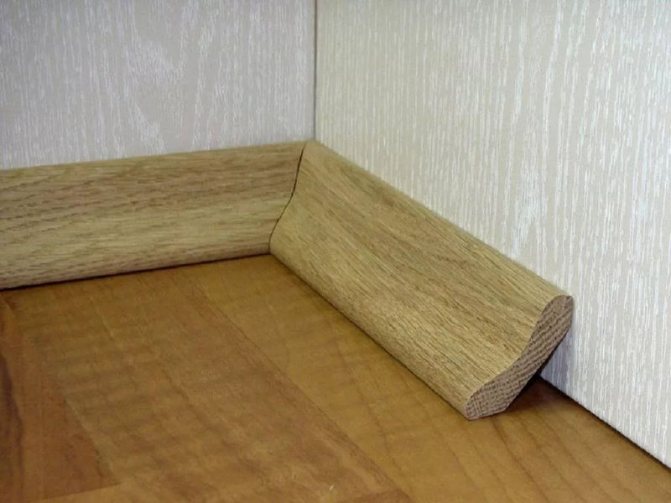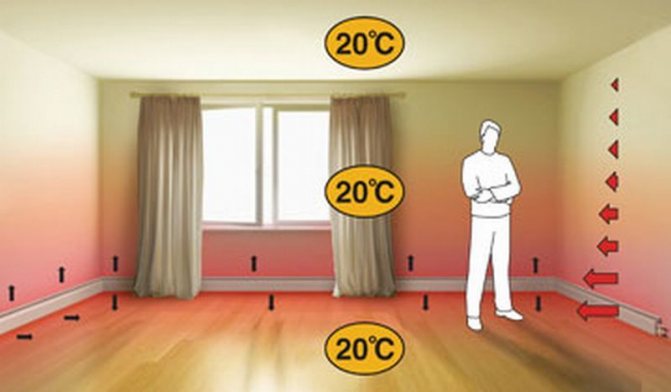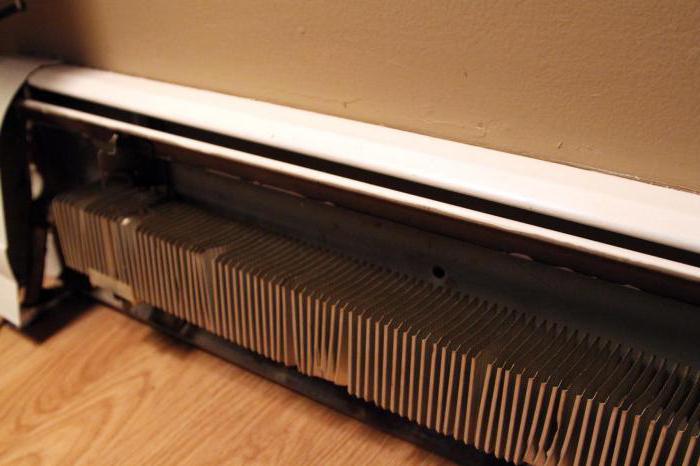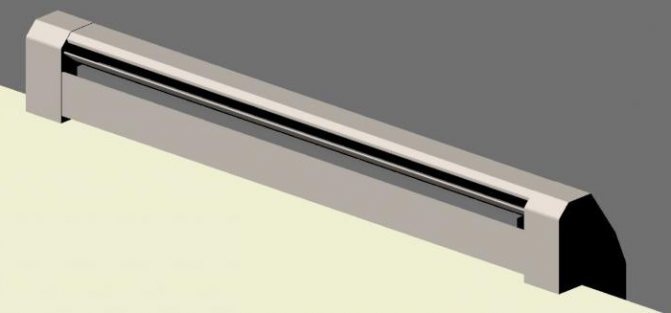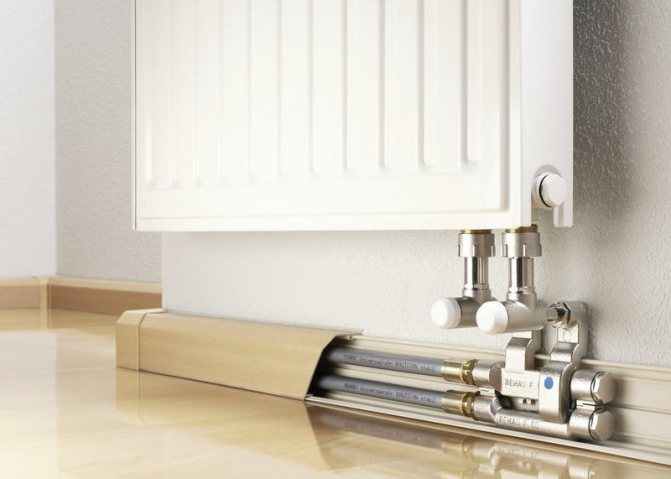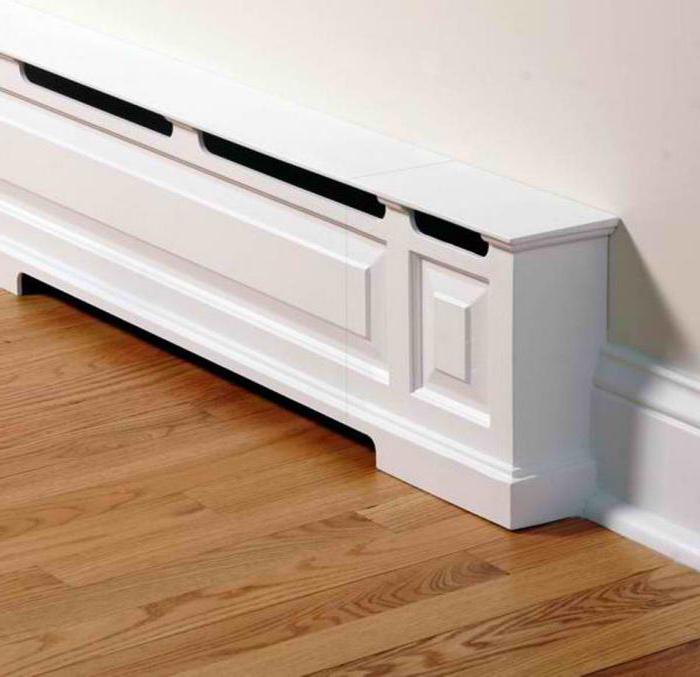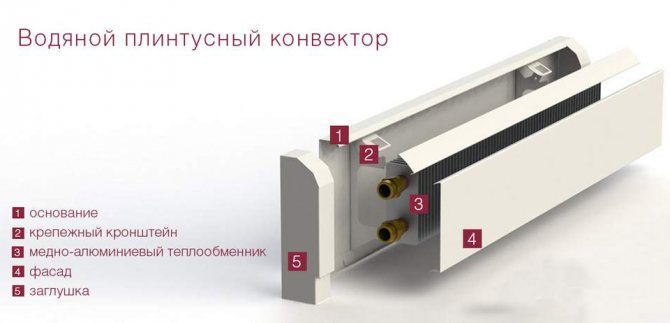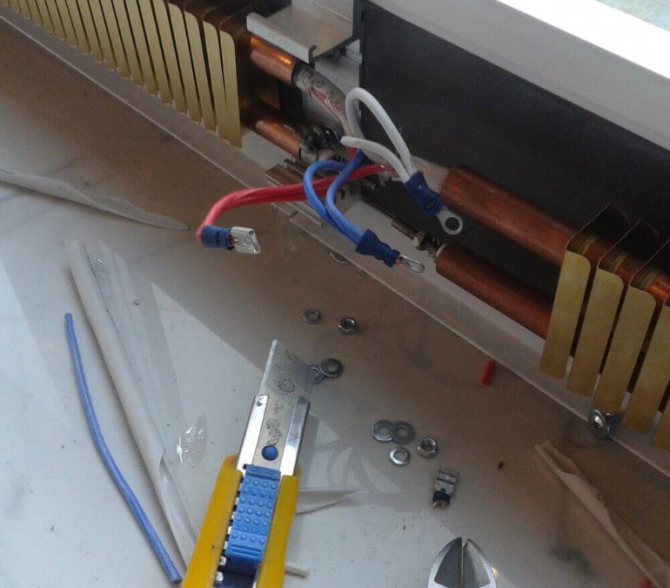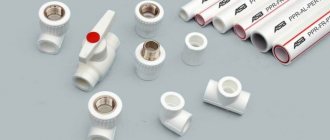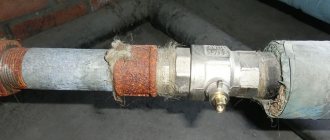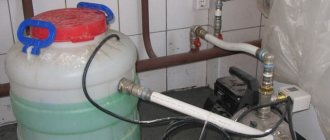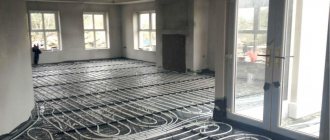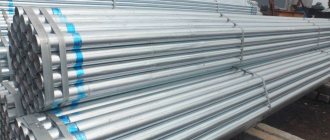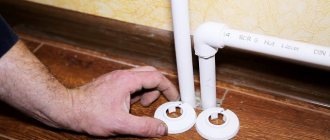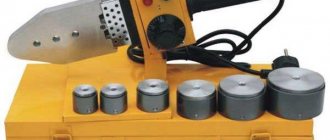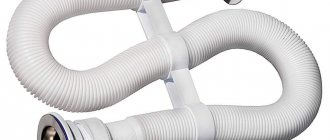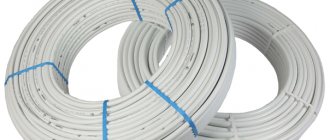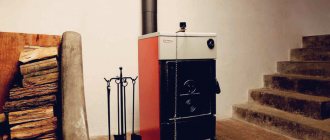Overview of baseboard heating systems
1. Liquid baseboard heating.
The water heating system includes the following elements:
- Radiator block: a heat exchanger made of two copper tubes, on top of which are fixed brass or aluminum lamellas, ensuring the convection process, and a protective and decorative aluminum box.
- Distribution manifold, consisting of two steel tubes for the input-output of the thermal carrier. Additionally equipped with air vents, cut-off valves and drain valves.
- Corrugated polyethylene pipes through which liquid is delivered and discharged. They are mounted along the wall or in the floor. The maximum working pressure should be about 3 atmospheres.
Skirting water heating is sensitive to water hammer and an increase in current pressure as a result of crimping, therefore, instead of polyethylene hoses, metal-plastic or copper communications are used to connect to a centralized system. Fastening is carried out by soldering. At the same time, experts recommend using an intermediate heat exchanger that takes over all the "surplus". Thus, the skirting-type heater is protected from excessive loads, and its service life will correspond to the declared 10 years under warranty.
In private houses, a circulation pump, thermostats, sensors at the inlet of the thermal carrier to the collector receiver are connected. To buy a liquid warm skirting board, you will have to spend from 4,000 rubles per rm. m. Manufacturers, as a rule, recommend mounting a circuit no longer than 15 m. Otherwise, the efficiency of the system is significantly reduced. The standard surface temperature of the skirting board should be about +50 ° C, with each additional meter the indicator deteriorates by 2-5 degrees under the same conditions.
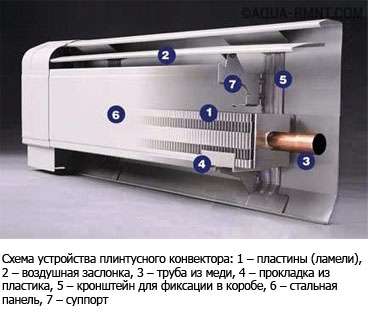
According to reviews, liquid-type baseboard heaters, although expensive, are effective:
“I installed a plinth heating system in a 20 sq. M. Nursery. m. The declared power was 200 W per linear meter. In the mode of initial warming up from -10 to +20, the complex proved to be excellent - literally 20 minutes later the room became warm and cozy. In the future, I will use half of the productivity to maintain the achieved results. "
Veshin Oleg, Tambov.
“A dacha near the lake is damp and chilly cold. I chose plinth heating with a copper core for heating. Of course, it turned out a little expensive, but the advantages are immediately noticeable: the most even temperature throughout the room, there is no overheated air as with radiator heating. "
Alexander Shilov, St. Petersburg.
2. Electric baseboard heating.
The electric skirting board belongs to air heating systems. The device of the unit is similar to a liquid one. A heating element is mounted in the lower copper tube, a power cable in a heat-resistant braid is embedded in the upper one. The maximum power level is 280 W per 1 meter. The price of plinth heating starts from 2,000 rubles / r. m. Overall dimensions of the unit: height - 16, width - 4 cm, length - 1-2 m. Complete with external, internal and end caps made of PVC.
Many manufacturers produce both types of baseboard heating, while adapting them to any type of heat generator. Thus, the THERMODUL heating system works in conjunction with gas and oil boilers, solar panels. The design provides for the possibility of temperature control using thermostats.
Versions with an infrared system are also available.For example, the Russian Megador skirting-board heater has a power of up to 200 W, the heating area for 1 running meter is 8 m2. The scope of application is not limited: country houses, apartments, office and industrial premises, garages, greenhouses and others. The guaranteed service life is at least 10 years. Prices for thermal skirting boards depend on models, additional functions and, of course, the manufacturer.
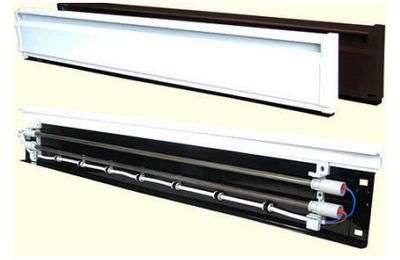

The cost of plinth heating in Moscow and the Moscow region.
Heating system classification
In a constructive sense, a warm skirting board is the main element, closed by a strip made of wood or aluminum. These are two copper tubes that are inserted into a metal case. The difference between the systems lies in the way the core of the device is heated. The combination of copper and aluminum is optimal for both types and has proven effective in heating.
1. Equipment with liquid carrier:
- Plinth water heating includes several components - a radiator, plastic or copper pipes, a distributor.
- A liquid circulates along the contour, the calculation of which implies 0.35 liters per 1 running meter at a temperature of 40 to 85 ° C and an internal pressure of no higher than three atmospheres.
- All elements are connected into a common contour, the length of which is 15 m.
- The most rational solution is to connect to central heating. The system is equipped with a thermostat, pump, temperature and pressure meter.
- Fastening of communications is carried out by soldering pipes, while it is recommended to use an intermediate collector, which takes over all the surplus. This will protect water heating in the form of a skirting board from loads.
2. Electrical system.
Such a skirting board is of the air type, its design features are identical to equipment with a liquid carrier, but there are some differences:
- The system consists of a silicone cable located in the upper circuit and a tubular electric heater in the lower circuit.
- It is connected to a regular outlet, taking into account the power of 200 W per 1 meter. It is recommended to lay a separate branch with a switchboard and an automatic machine. The parameter of heating elements ranges from 140 to 500 W at a temperature of 80 C.
- Electric baseboard heating is supplied with thermostats and registers for regulation. A grounding system is mandatory, for which a special clamp is installed.
Review of opinions
Feedback on the heating device mainly confirms the efficiency of the equipment:
“We installed a skirting board in combination with a floor heating system. Heating, of course, took some time, but the wait was worth the effect. I was especially pleased with the common wall with the veranda, which was constantly getting wet. Now it is always dry, condensation does not collect. We set the temperature to 25 degrees, this is suitable for all family members. As a result, there is not a single cold corner in the apartment. "
Egor, Moscow.
“The house is located far from centralized heating and is not yet supplied with gas. After spending a week searching the Internet, we decided to buy and install an electric skirting board. At first, we were worried that the bills for the service would come huge, but they even managed to save money, since the regulators helped. We set the most comfortable temperature. We tried to turn it off at the time when everyone was at work. The walls are cooling down very slowly, the cold air was not even felt. "
Natalia, Yaroslavl.
“We have underfloor heating in two rooms, and after reading the reviews, we decided to buy a plinth in the rest of the rooms. The last option pleased me more, the savings are more tangible, it looks beautiful, there are no cables in sight. The specialists made the installation as soon as possible, left clear instructions for working with the regulators. Now we are thinking about the advisability of installing the system in a country house. "
Ruslan, Tula.
“Quite a decent heating option. I installed it personally, I can note that in order to avoid losses, a large length of pipes is required. But you can put a more powerful pump for circulation, and then it will turn out to make each circuit shorter. It is also best to use small heating equipment. I want to emphasize that those who like to litter rooms with unnecessary furniture will have to think about it. Since the plinth will work not only on walls, but also on sofas and cabinets installed right next to them. "
Alexey, Moscow.
obogrevguru.ru
Advantages and disadvantages of baseboard heating
The advantages include:
- fast, and most importantly, uniform heating of the room, since, in fact, the wall of the room is used as a heating surface for air;
- economical - thanks to the heating rate, heating costs are reduced. In turn, the heat curtain, which is formed by the flow of heated air near the walls, prevents heat loss through the wall partitions;
- with the best thermal insulation, the possibility of damping the walls is quite high. Heating them noticeably reduces the risk of condensation accumulation, mold formation, and, therefore, the destruction of materials;
- low inertia - due to their small size, the devices "turn on" faster. The same feature makes it easy to adjust the temperature in a very short time;
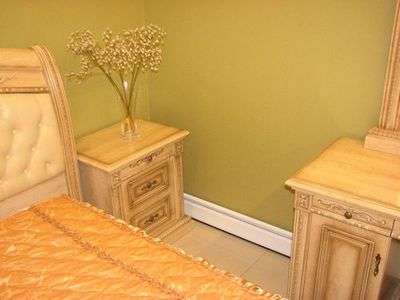

- thermoregulation is possible on an individual basis for each room;
- fairly simple DIY installation;
- decorativeness - the heating plinth is not much wider than the usual floor one. The entire heating system is hidden from view and does not interfere with the placement of furnishings at all. The only rule that is recommended to be observed is not to place large pieces of furniture over the heating element, as this reduces its effectiveness.
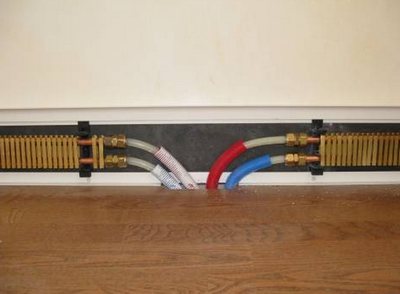

Disadvantages:
- the method is designed for a limited area - the length of the contour should not exceed 15 m;
- installation of the system is the last simplest stage of work. Preliminary calculations and preparation require much more time and accurate calculations;
- the system is effective only if the house is very well insulated.
Advantages and disadvantages
- Uniform heating of the room without cold and warm zones.
- Oxygen is not burned out.
- Reducing the cost of maintaining a comfortable temperature by lowering it by several degrees
- Heating is carried out by thermal radiation from warm walls.
- Convenience of embedding into any interiors.
- Easier installation (compared to underfloor heating).
If you do not take into account the statement "they will not heat anything," there is only one drawback so far: high price. There is one more, but indirect: a water warm plinth - a multicomponent system
It is not easy to design and connect everything correctly. Electric skirting boards are a little easier, but electrical skills are required. That is, in both cases, installation by professionals is desirable, or detailed clarification of details and features from dealers or manufacturers.
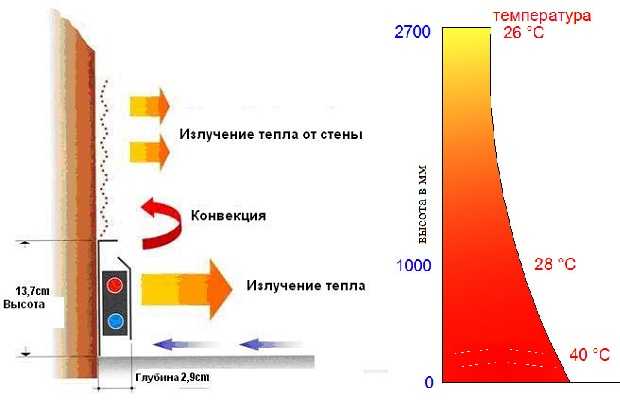

The principle of operation of baseboard heating in a graphic image: at head level (approximately 1.6-1.7 meters), the temperature reaches a comfortable 18-20 oC
Skirting-type heating system working principle
The warm skirting board functions due to the Coanda effect, i.e. due to the reduced pressure generated in the area of its surfaces. Only one side of it has free access to air. The air flow spreads over a large area.
Such a heating plinth requires the installation of radiators on the outside of the wall. The box made of aluminum strips has a pair of horizontal holes. When a cold air stream enters, it heats up and rises up. Thus, the entire wall surface is heated as evenly as possible.
Due to the fact that such a heating plinth works without the participation of convection, strong heating of the coolant is not required. Such radiators have a pipe structure made of heat-conducting materials, for example, copper or aluminum.
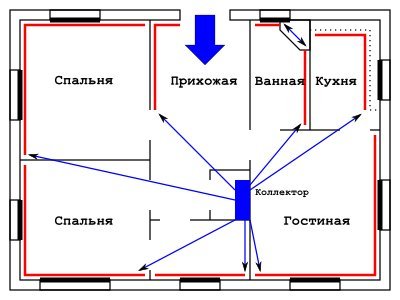

Radiator installation diagram in a 3-room house.
One-pipe heating system
This option for distributing heating pipes is also called sequential.
Features:
- You can make a gravity loop;
- A fairly economical option, a minimum of materials is required for its implementation;
- Combines with open systems;
- Depending on the distance of the sources, the temperature of the radiators changes, the closest one will be the warmest, the extreme one - the coldest;
- It is necessary to install bypasses, otherwise, if any battery clogs, the system stops working;
- A powerful pump is required for the forced flow of fluid;
- Strict restrictions on the number of radiators in the riser.
But the use of modern solutions allows you to partially or completely remove all the disadvantages of this type of wiring. One-pipe systems are vertical and horizontal. In the first version, the coolant goes up a pipe located under the ceiling or in the attic. Then from there the pipes are lowered to the radiators. The use of a vertical system allows the natural flow of fluid to be realized, so no pump connection is required for its operation.
Decorative rosette
Decorative finishing of heating pipes running through the floor becomes an acute problem when laying parquet flooring. There are two methods for finishing heating pipes.
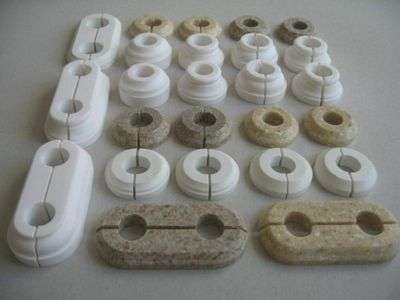

Decorative overlays for heating pipes
The first method assumes the following: The pipes are quite tight, without leaving gaps, turn to turn, wrapped with asbestos-containing cardboard. This is done at the height of the future skirting board. After that, the place around the pipe is laid with a heat-resistant material with good elasticity.
To cover up the cracks, a simple cement mortar is used.
The second method is even simpler. The gap between the parquet and the pipe is filled with an elastic sealant with good heat resistance. The place where the floor and the pipe meet is masked by means of a decorative rosette. Thanks to the wide range of sockets, they can be matched to pipes of any diameter. Sockets for heating pipes consist of two parts, and their connection takes place thanks to a spike. At the junction of the two parts, the sockets are smeared with glue. After the glue dries, the rosettes are connected in a way to the girth of the pipe, and then they are pressed to the floor as tightly as possible. Remove the remnants of the glue with a soft cloth.
Warm skirting board
Plinth heating pipes are a novelty borrowed from our American friends. First, let's figure out what kind of beast it is. The radiators are two copper pipes connected by jumpers. Thanks to these fins, the heat transfer area increases. They are installed along the entire length of the walls. Their design allows you to cut elements of any length. Several connection plates must be removed to free the pipe ends. They are not fixed and can be easily removed.
A warm plinth does not warm the air, but the walls and floor. The heated surfaces, in turn, give off heat to the room. Without good wall insulation, this system will be ineffective.
There are:
- water-based - according to the principle of conventional water heating, water circulates in warm baseboards;
- electric - heating elements are inserted into the pipes, which are the main heating element.
The distribution of heating pipes with fins is carried out in boxes. What is characteristic is that foil is glued on the box lid and there is practically no air access to the warm circuit. A fair question arises as to how, then, this warm plinth heats the room.The bottom line is that it works on a completely different principle than the usual batteries. Radiators heat the air and if they are closed with a dense screen, convection will be disturbed and the amount of heat in the room will be less. Consider this when decorating batteries.
A warm plinth does not heat the air, but the walls and the floor, which then give their warmth to the room. According to the assurances of manufacturers, it has the following advantages:
- increases the heat exchange area;
- reduces heating costs;
- invisible in any interior;
- heats the room evenly from bottom to top;
- eliminates the appearance of mold and mildew in the corners and on the walls.
In practice, not everything is so rosy. Before dissolving skirting-type heating pipes, you need to take care of the thermal insulation of your home. If you have non-insulated walls, then you will heat the street and not otherwise. A warm plinth will heat up the walls, and they will successfully give almost everything to the street. It is also important that the layer of insulation must be substantial. In a harsher climate than in America, such a heating system is not able to independently heat the house, except perhaps in tandem with warm floors. But the question arises, if there is a warm floor, why is it spent on a warm baseboard, because it is not a cheap pleasure.
Do not confuse heating a warm skirting board with skirting-type convectors that heat the air and require convection (movement of air currents).
Types of skirting covers for heating pipelines
The main feature of the classification of skirting boards for heating pipes is the material of manufacture, which can be divided into 3 main groups:
Each group includes many options for execution, differing in size, profile, color, surface texture, etc.
In addition, to the specified items, you can add a group of self-made boxes, which are made on the basis of a cd-profile frame mounted to the wall, followed by plasterboard sheathing and finishing with plastic, ceramic tiles or mosaics.
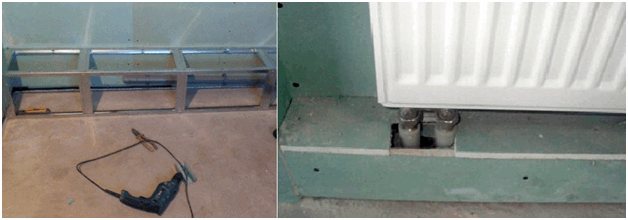

- covers without pipe brackets (screens) - are attached to the wall over the mounted and fixed pipeline;
- casing complete with pipe holders - mounted on installed holders with pipes.
The choice of a decorative plinth should be made with reference to the specific operating conditions, including many factors (installation location, diameter and number of pipes in the string, the presence of thermal insulation, etc.) and the interior of the room.
Consider options for hiding heating pipes, and several types of decorative plinths used to decorate pipes for heating systems.
Skirting metal screens
The products are covers of oval or rectangular cross-section made of aluminum or stainless steel, which are butt-to-side fastened to the wall with self-tapping screws over the installed pipeline. The surface of such a plinth is perforated, which reduces the weight of the product, makes the heating of the room more uniform and allows visual inspection of the tightness of the pipeline. The casing is strong, in case of mechanical damage it is restored by straightening, it is easy to assemble and can be painted.
Such a plinth can be cut into fragments of any length, including those convenient for positioning above the valves of the valves in case they need to be replaced or repaired.
The casings are installed at any height of the pipe laying, it is possible to place them directly along the interface between the floor and the walls.
Plastic skirting boards
Plastic skirting boards for heating pipes - a budget solution to the issue. The characteristics of the plastic used for these purposes are generally low.Scratches from mechanical damage remain on the products; after a year of operation, some varieties have deviations from the original geometry. But a wide range of material prices allows you to change skirting boards every year or two without special costs, at the same time bringing new touches to the interior of the room - there are many options for the artistic performance of these accessories (for valuable wood species, natural stone, etc.).
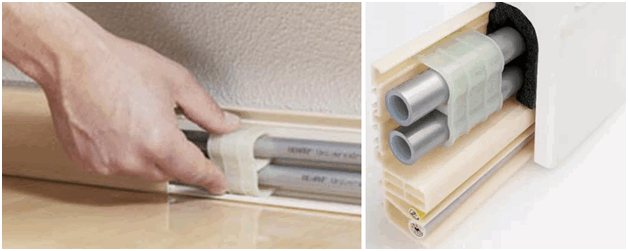

Wooden skirting boards
Wood products are not made in the form of universal models, since the cost of natural wood suitable for a heat-resistant shell is high. Therefore, such finishing is ordered in carpentry or furniture workshops according to individual sizes and sketches.
Wood skirting boxes are beautiful and durable when properly processed and properly cared for. The color of the wood before coating with a protective layer of varnish can be changed by applying a stain - a tinting composition produced in various colors and saturations.
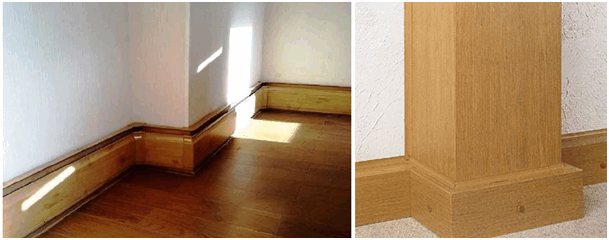

Wood skirting boards are mounted on brackets previously fixed to the wall. The inner surface of the products goes through all the necessary types of processing before installation ("Antizhuk", two layers of nitro-lacquer), and the outer surface is made out after the final adjustment of the entire contour of the plinth finish.
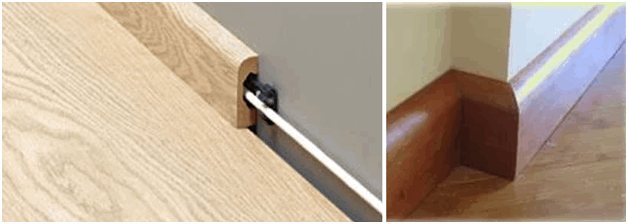

Types of skirting boards for heating systems
Skirting boards for heating systems are made of heat-resistant plastic, metal, laminated particle boards. The main condition for the protective casing is the presence of longitudinal holes at the bottom and top of the structure.
The materials used in the manufacture of skirting boards should not be afraid of moisture, be resistant to abrasion, mechanical and chemical influences. This will preserve aesthetics during prolonged use The environmental characteristics of products are important - the material should not emit harmful chemicals when heated.
The following types of skirting boards are popular:
- Perforated enamelled metal structures. They are maximum in heat transfer, visually light, do not burden the interior. Such designs can be made independently or purchased ready-made. Metal structures are easy to install, they can be cut, connected in any variation.
- Skirting boards imitating expensive wood species. They are made from plastic or laminated plates. Lovers can order products made of natural wood, but in addition to expensive materials, you will have to pay for the mandatory protective treatment. The wood is treated against fungus, etched with refractory compounds.
- Paintable aluminum skirting boards. They are loved by those owners who want to make the heating system invisible, merge it with the walls. Aluminum structures are characterized by lightness, strength, practicality, and an affordable price.
We recommend that you familiarize yourself with: How to avoid mistakes when installing a chimney from a sandwich pipe through the ceiling and roof
Skirting heating what is it
There is a fairly large number of interesting and fairly economical systems on the market that an ordinary city dweller is not able to use. This is most often due to the inability to provide sufficient thermal insulation for the apartment. Another thing is your own house, where you can achieve really high performance. This, in turn, allows the use of non-traditional heating options.
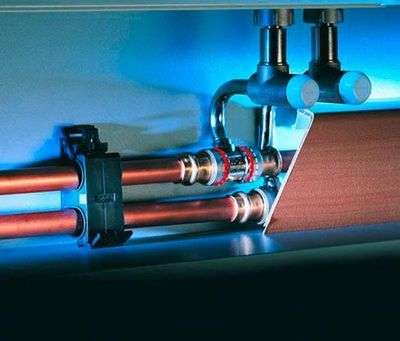

Plinth heating refers to just such systems. It got its name thanks to the installation method: the radiators used for heating are very small in size - 3 * 14 cm, and are installed along the wall of the room. In appearance, they practically do not differ from the usual floor plinth.
The principle of operation is as follows: cold air at floor level is taken into the radiator through the lower hole, heats up on the surface of the heat exchanger and is fed into the room through the upper hole.The peculiarity is that the heated air does not move immediately throughout the entire volume of the room, but spreads along the wall, first of all, heating its surface. Accordingly, the room is heated not so much by the flow of warm air as by the surface of the heated wall. Such a system, judging by the reviews of mainly European consumers, has many advantages. The photo shows an example of such heating in a private house.
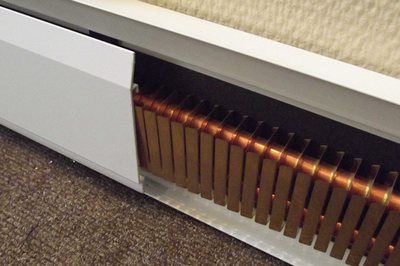

What is
Plinth ducts for heating pipes are mounted around the perimeter of the room. The structures contain heating elements, from which warm air rushes up the walls and from them spreads around the room. Heating skirting boards are designed to completely replace the usual heating radiators, providing an opportunity to free up additional living space.
The contents of the channels (pipes, radiators) are covered with a decorative casing of a special design with longitudinal holes at the bottom and top. In this case, the decor can be made of plastic or metal parts.
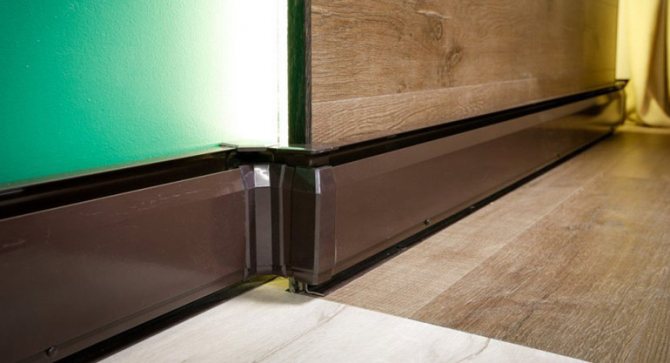

The dimensions of the plinths for heating pipes do not exceed 13.5 cm in height and 3.6 cm in depth (width).
How the system works
The plinth heating system is organized in such a way that the heating elements are installed along the perimeter of the outer walls of the building near the floor, close to their surface.
The box of the heating element, formed by aluminum strips, has in its design two horizontal slots running along its entire length from opposite sides - one at the floor, and the other at the top.
Cold air penetrates through the lower slot into the plinth, where it heats up and rises, but unlike other heating devices operating on the principles of convection, then the heated air, obeying the Coanda effect described above, spreads only along the surface of the wall, giving off heat to it.
As a result of this movement, only this surface is heated, and not the volume of air in the room. Then the already heated wall begins to uniformly radiate heat in the infrared range.
Distribution of temperature zones in the volume of the room
This design requires the use of materials with high thermal conductivity, for which copper and aluminum are optimal. Since heating occurs not due to convection, but as a result of the transfer of radiant energy, there is no need for a high-temperature coolant.
Even in the maximum operating mode, the aluminum box of the heating element heats up to a temperature of no more than 40 ° C, and the wall where it stands, respectively, no higher than 37 C, which is completely safe and eliminates the possibility of burns.
Positive qualities of the system
The positive qualities that heating in skirting boards has include the following:
Differences between the "Warm plinth" system from conventional batteries
- Heat is evenly distributed throughout the volume of the room. Due to infrared radiation, only opaque objects in the room are heated;
- The entire volume of air in the room warms up evenly, in contrast to convection heating, where the warmest air accumulates at the top;
- There is practically no convection movement of air masses, respectively, a minimum of suspended dust particles is formed;
- Infrared heat radiation is perceived by the human body as natural;
- The surfaces of walls, floors and ceilings have a temperature close to the temperature of the human body and therefore do not take away heat from it. Since the surfaces are warm and dry, the problem of the formation and condensation of moisture on the walls and ceiling is eliminated;
- Regardless of the age of the building, skirting water heating is installed quite simply and quickly. Unlike the usual radiators, such heating elements are practically invisible;
- The system has a high maintainability, which does not require work on dismantling the finishing coating;
- Thanks to thermostats, you can individually adjust the optimal microclimate in each room;
- The low temperature of the coolant has a positive effect on the efficiency of the system, allowing you to reduce energy costs by 30-40%.
Features that can be attributed to disadvantages
Despite the obvious advantages, plinth distribution of heating pipes has its own disadvantages, which include the following:
- Limitations on the length of one heating circuit - its length should not exceed 15 meters, otherwise the efficiency of the "warm plinth" system is significantly reduced. In this situation, you simply cannot do without a distribution manifold;
- It is necessary that the heating elements are as open as possible. It is not recommended to block the surface of the walls with cabinet furniture, as this can cause distortion of air flows and interfere with IR radiation;
- Decorative skirting boards must not be installed on heating pipe skirting boards. since they will reduce heat transfer:
- Due to the tight fit of the radiators to the wall surface, only heat-resistant materials that are not subject to deformation and cracking can be used for interior decoration;
The price of the system is quite high due to the use of high-quality expensive materials in the construction, without which it is impossible to achieve high work efficiency.
The principle of operation of the baseboard radiator
Radiators for baseboard heating can work with liquid heat transfer agent and with electric heaters.
Plinth water heating radiators are very similar to Soviet ribbed batteries, which were everywhere installed in apartments, only in a reduced version. These are two tubes connected by plates. Due to this, the heat exchange area increases. The product is made of copper, as its thermal conductivity is higher than that of steel or aluminum.
Skirting heating with radiators can be water or electric. In any case, the installation of the heat exchangers themselves is carried out first. The radiator comes with a box. First, the mount for the box is installed, and then the copper heat exchanger is attached to the wall. If we are talking about plinth water heating, then you need to connect the circuit to the boiler and pour liquid into the heating system. The supply is started up through the upper tube, and the return flow through the lower pipe. Everything is as in the usual circuit, the plinth wiring of the heating system is no different in this regard.
At the end, the box is closed with a lid, on which an aluminum tape is glued from the inside. It reflects heat so that it does not pass directly into the room. Plinth heating water should give all its heat to the wall, this is the key point of this method of heating the room. The diameter of the tubes was not chosen randomly.
The flow rate of the heating medium in baseboard heating must be higher than in a conventional high-temperature circuit.
Therefore, powerful pumps are needed. It is noteworthy that the delta of the supply and return temperatures is no more than five degrees, while in a conventional system this figure reaches twenty degrees. Also, the water temperature in the system does not exceed 60 degrees. Algorithm of work of water baseboard heating:
- the coolant circulates through the radiators and heats the plates;
- plates transfer heat to the wall;
- the wall heats up evenly and gives off its heat to the room.
Such is the tricky scheme. Why is this needed? This heating method is designed to distribute heat evenly. If there is no convection, then there are no air currents that drive dust. How important it is to decide for yourself. Indeed, in addition to convection from heating, there are also people and animals in the house, they move and also create air movements.A vacuum cleaner or a broom in this case, in general, is enemy number one.
Electric skirting board heating is somewhat different from water heating. A special heating rod is inserted into the same copper radiators. Liquid coolant is not used in this case. A rod is inserted into the lower tube and a cable runs through the upper tube that supplies the heating element in each radiator with electricity. The algorithm of work is no different from the water one - the main thing is to heat the walls.
Warm skirting system what is it
Heating skirting boards or skirting board heating are not new in the field of heating. The idea was proposed at the beginning of the last century, but due to the complexity of implementation and the high price, it was almost forgotten. With the development of technology, the complexity has become lower, but the price is still high. This is, in the main, and holds back potential users.
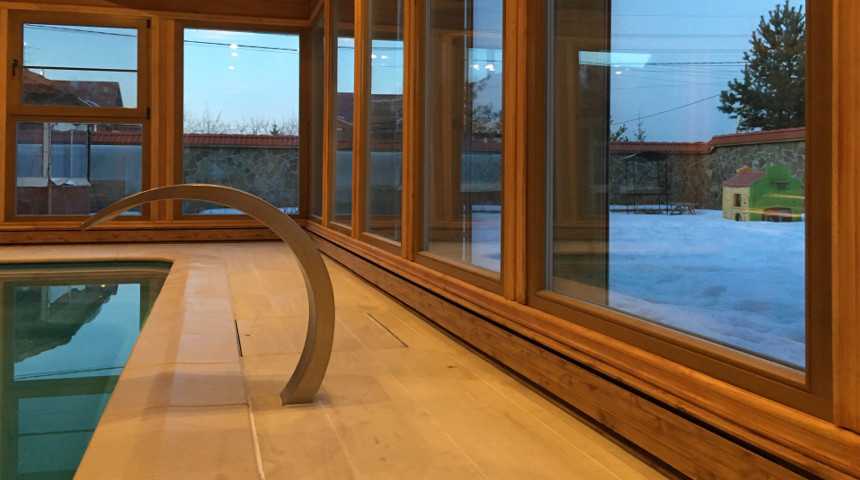

This is how heating with a warm plinth might look like.
The main difference between this system is the non-standard form of heating devices and their unusual location. Heaters are long and low, located around the perimeter of the room at floor level. The heaters are covered with a long decorative strip, which looks very similar to a plinth. When installing, replace the usual skirting board. That is why such a system is very often called "warm skirting board". This system is very good for panoramic glazing - it can be no higher than the frames, so it is completely invisible. She is no worse in ordinary rooms - she is not visible at all.
Types of warm skirting boards
There are two types of warm skirting boards: electric and water. The electric warm skirting board differs in that each heating device is independent and can work separately. They can be installed in the event of a lack of capacity of the main heating - as an additional one, in case of cold weather. The installation is simple, but it works efficiently, is invisible, does not dry the air too much.


Warm skirting board without decorative panel
There is a warm water baseboard. This is one of the subspecies of water heating, that is, all heating devices are connected into one system. It can be either the main type (only skirting heaters) or an additional type of heating (together with a water-heated floor or radiators).
Heating plinth device
In any case, a warm plinth looks like this: these are two copper pipes, which are at a distance of 7-15 cm from one another.To increase heat transfer, vertical plates made of aluminum, brass are put on the tubes (they cost a little less, but the heat transfer is slightly lower) or copper (more expensive and "warmer" option). The finned tubes are closed on top with decorative extruded aluminum covers. Aluminum was not chosen by chance - it transfers heat well. So the heated lid itself emits heat.
There are openings at the top and bottom of the cover for air movement. Cold is sucked in through the lower ones, heated through the upper ones. So it turns out heating comes from three sources:
- The air is heated, which passes along the pipes and fins.
- From heated walls.
- From the body of a warm metal baseboard.
Such a triple heat source contributes to the fact that the room heats up quickly, and the location of the heating elements around the perimeter contributes to uniform heating of the air throughout the volume.
Appointment
Heater skirting boards can serve as both the main source of heating for the home and as an addition to the existing heating system. Depending on the variant of heating elements, they can be installed in private houses, in an apartment, on loggias, in garden houses, garages, a winter garden, and industrial premises. Electric cable skirting boards, for example, are used where the placement of other heating systems is impossible. Plinth heating pipes protect the wooden parts of the house from moisture well.
Heating skirting boards work effectively in rooms with panoramic windows.Thanks to the rising warm flow, rooms are heated completely and evenly, large glasses do not fog up.
Functional features of plinths for pipes of heating systems
There are many options for the execution of mounted piping finishes, the plinth for heating pipes is also not monotonous in terms of decoration, but this material, depending on the location, has design features. If the heating pipeline passes through an unheated room, then the pipes must be equipped with thermal insulation in order to reduce heat loss, and the body of the decorative casing must be solid - without holes and slots. The degree of its aesthetics depends on the status of the premises and the desires of the residents.
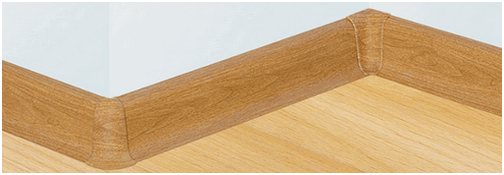

If the wiring is made in a residential room and in need of heating, then it makes no sense to insulate it - heat transfer from the surface of the pipes will occur into the air of this room, and this is not heat loss. Therefore, decorative skirting boards for heated rooms can have through perforations or artistic cutouts, which are even desirable for a more uniform heating of the room air and less thermal effect on the baseboard material. However, it should be borne in mind that it is more difficult to keep such surfaces clean than smooth ones.
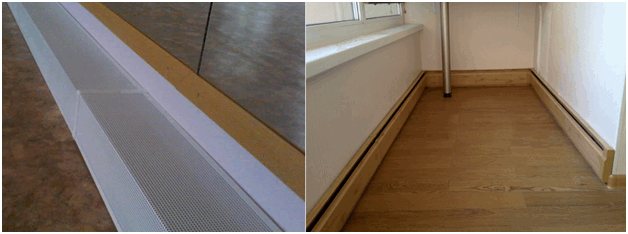

Plinth wiring
When are heating pipe skirting boards used?
- If it is impossible to lay the wiring in a screed or under a floor floor (usually due to the limited height of the room). With a ceiling height typical of Soviet construction of 245-250 cm, its reduction even by 50 mm is highly undesirable;
- When using serial wiring of heating devices. Unlike the collector, it assumes the presence of tees on the inset of each radiator. It is the greatest folly to mount detachable connections in such a way that to access them it is necessary to open the floor.
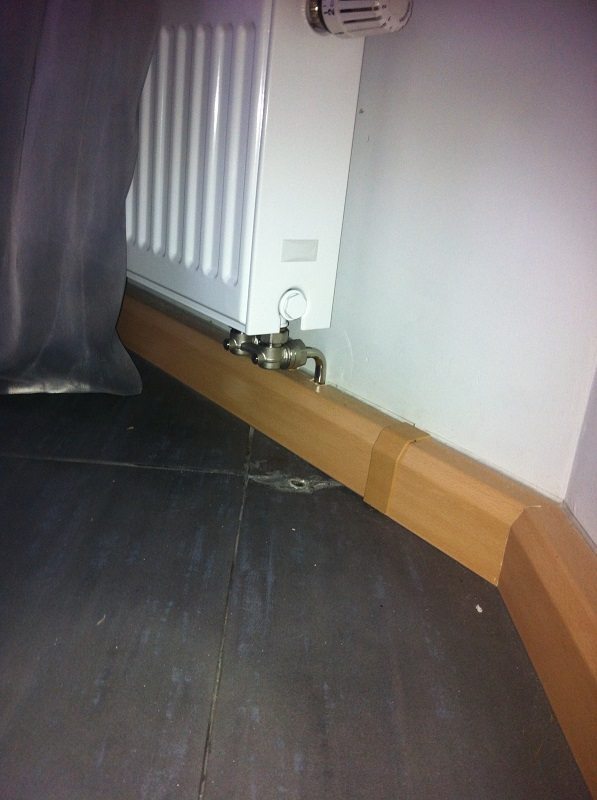

The heating distribution is hidden by a decorative skirting board.
Is it difficult to remove heating pipes under the baseboard? All problems are associated exclusively with the proximity of the plug connections to the floor and to each other.
Practical implications:
- The fittings on the supply and return pipelines are not mounted one above the other, but with a slight horizontal offset. The instruction is due to the fact that otherwise, when disassembling one of the fittings, the tool will rest against the other;
- Throttling and shut-off valves are taken out of the box and mounted directly on the connections to the radiator.
Requirements for finishing the heating pipe under the plinth
Finishing materials used to decorate elements of heating systems must have the following characteristics:
- low flammability;
- sufficient heat resistance - the ability to maintain geometry and aesthetics when exposed to heat;
- low coefficient of thermal expansion;
- hydrophobicity - resistance to moisture (with daily care and emergency leaks);
- resistance to chemicals (household chemicals);
- safety - no harmful emissions and odors under the influence of temperature;
- ease of installation and daily maintenance;
- resistance to mechanical stress - when rearranging furniture, etc.;
- aesthetics.
All of the above applies to skirting boards for hiding heating pipes.
Warm floor
This is a separate type of heating in one pipe. In such heating, the heating pipes are laid along the floor, and then the circuit is filled with a layer of screed. The principle of operation is that the pipes evenly heat the screed, and that, in turn, gives off heat to the room. At the same time, there are significant advantages:
- at home there are always warm floors. You can walk barefoot all year round and no need to lay carpets;
- the temperature is higher at the bottom than at the top. If you use ordinary radiators, then it is much warmer under the ceiling than at floor level;
- the ability to regulate the floor temperature;
- no batteries, which is undoubtedly an advantage for any interior.
Heating system layout in one pipe, diagram:
- snail;
- snake.
The snail pattern is more common and involves twisting the pipe around the perimeter of the room from the walls to the center. At the same time, there are no sharp turns that could slow down circulation. The "snake" scheme involves laying a contour from one wall to another, while the coolant constantly changes its direction of movement by 180 degrees.
What you should pay attention to during installation:
- a hydro-barrier and reflective insulation must be laid under the circuit so that the heat only rises up;
- the distance between the pipes must be the same so that the floor warms up evenly;
- the screed layer must be at least 5 cm, otherwise it may crack.
Also, you can not make breaks in the warm floor. It is made from a solid line.
Water baseboard heating
The basis is the radiators, into which the heated coolant is supplied. The system, in fact, is a version of water heating and consists of a boiler, collectors - a supply pipe and a return pipe with connection fittings, the plinth itself - radiators, and a plastic double pipe through which water circulates.
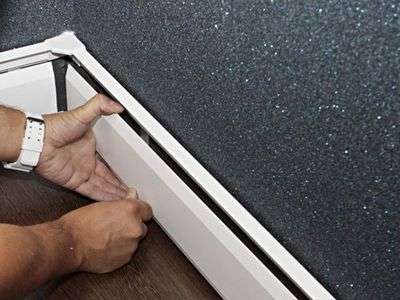

The radiator consists of a heat exchanger and a box. The heat exchanger is usually a copper tube on which numerous aluminum or brass plates are attached to distribute heat and form a vertical airflow. The supply pipe is installed in the floor or wall and is hidden from view - this method not only ensures the compactness of the system, but also reduces heat loss.
It is recommended to install hot water heating during repairs, especially when it comes to the option with the placement of the pipeline in the floor.
- The return flow collectors are mounted on the wall using anchors. The place must be accessible for service.
- The collectors are connected to the supply and return pipes to the boiler. In most cases, a threaded connection is assumed, which facilitates do-it-yourself installation.
- From the collector to each radiator, two tubes are stretched - supply and return. They can be mounted on the wall or on the floor.
- At the planned places, fasteners for radiators are mounted - its type depends on the design of the device.
- A radiator with a connected pipeline is fixed to the fasteners.
- Decorative boxes are fixed on top. The photo shows a variant of using a warm water baseboard.
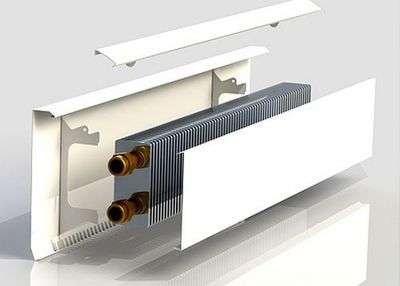

Water or antifreeze is used as a heat carrier. The system is completely filled with liquid, air is released using special fittings.
Electric baseboard heating
Installation of this option will require preliminary laying of a power cable with outputs for connecting radiators. The advantage is the absence of a heating boiler, the disadvantage is the increased consumption of electricity. As in the previous case, do-it-yourself installation is the last and easiest stage, judging by the reviews. The photo shows an electric baseboard radiator.
When organizing electric heating, you should accurately calculate the power of the devices used and their number. You cannot connect more than 17 radiators, while their total power should not exceed 200 watts.
- On the wall, at one level, the fastening is marked. According to the configuration of the rear wall of the radiator, holes are drilled in the wall and dowels are fixed.
- The fasteners must be carried out in such a way that there is a gap of at least 1-2 mm between the plinth and the floor in order to avoid overheating.
- A radiator is attached to the installed rear wall. Power jumpers are mounted and must be grounded.
- The modules are connected to the mains in parallel.
- Radiators are covered with decorative boxes.
- The thermostat is fixed to the wall in such a way that the distance required by the instructions is observed between it and the radiator. The thermostat measures the air temperature in the room, and therefore should not be obstructed by any interior details or furnishings. It is desirable that the power outlet is near.
- A trial run of the system is in progress.
The video shows in more detail the installation of baseboard heating.
Heating for Russia is not a luxury, but a necessity. The centralized system provides a comfortable temperature of +20 ° C, but the distribution of heat throughout the room is uneven. Physics comes into play: heated air goes up, cold air goes down. Is there an option in which the house is thoroughly warmed up without additional costs for underfloor heating? Yes, this is the so-called baseboard heating.
Two-pipe system
In two-pipe heating schemes for a private house, piping is carried out in two planes. This heating system is the most widely used. The essence of the circuit lies in the parallel connection of radiators. Parallel piping of heating pipes makes the system balanced, and there is no need to make complex calculations. If we are talking about a small house, up to 150 m2, then the temperature of the first and last distributors will practically not differ. The difference of a couple of degrees is so insignificant that it will not affect the room temperature in any way.
Two-pipe systems, like one-pipe systems, can be vertical or horizontal. Vertical can differ in the method of eyeliner: top and bottom.
The distribution of heating pipes in a private house is carried out from the boiler and can be performed in two versions:
- vertical.
Vertical layout of the contour is used only in houses with two or more floors. This method involves connecting heating radiators to a vertical riser.
At the same time, there are different schemes in which the location of the distribution line is different:
o at the top;
o at the bottom.
The upper connection in a system with a vertical distribution of heating pipes in a private house is when the coolant rises along the central riser to the peak point where the upper line is laid. In open systems, an expansomat is also located there, it is also an air vent. With such a layout of heating pipes in a two-story house, the supply line is located in the attic, and it must be insulated. Risers go down from it, and distributors are connected to them. After the first radiator in the vertical circuit, a second return flow riser is added.
Heating in a new building can also be attributed to the upper piping, where the piping around the apartment starts from a vertical riser. In it, the coolant moves from top to bottom. In the case of the lower piping, with the correct routing of the heating pipes, the distribution line is located in the basement or basement, the return line is even lower. So the movement of water is from bottom to top;
- horizontal.
The horizontal heating distribution scheme is used in one-story houses. In this case, the mains are parallel to the floor - these are two heating pipes: direct and return. In this case, the pipes can be hidden under the floor, and two pipes will rise to the radiators. Horizontal wiring of heating pipes in a wooden house is carried out according to three schemes:
o flowing "b" (ride);
o dead-end "a";
o collector.
Based on this classification, there is a series and radial connection of radiators.
Horizontal two-pipe wiring is carried out according to three schemes: passing, dead-end, collector.
The flow-through two-pipe horizontal distribution of heating pipes is characterized by the same direction of movement of the coolant in the direct and reverse flow. Hot water, getting into the first radiator, gives off its heat.Then it leaves it and moves on, only along another pipe. In the course of the reverse flow, all the remaining batteries are cut into, and then the already cooled water is sent to the boiler room. Just like when laying heating pipes in an apartment, when the coolant moves along the way from one riser to another.
With a dead-end wiring of the heating system pipes, the heat carrier at the supply and return moves in the opposite direction. Water reaches the first radiator, and from there it enters the return flow pipe and immediately rushes to the heater. The same thing happens in all subsequent batteries. In each of these schemes, a series connection of distributors is used, depending on their distance from the heater.
In the collector heating system, the coolant from the boiler is directed to the collector, which distributes it between the batteries. From the collector to each radiator there are two segments (beams) - this is the supply and return. Therefore, this type of wiring is called radial. Installation of pipes is carried out with a hidden method under the floor. The collector itself has the form of a metal pipe with holes through which circulation is carried out. Collectors are installed in cabinets, which are usually hidden in a niche specially mounted for them in the wall.

